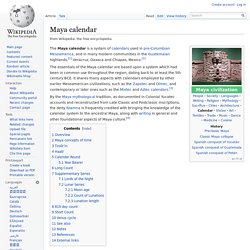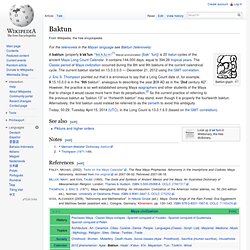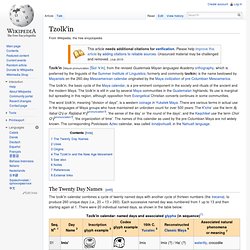

Maya Exploration Center. Maya Date Conversion Calculator. Mayan Information Links. Mayan Horoscope. Personality Traits of People Born on Certain Days A person is said to have a certain destiny and personality traits shaped by day sign under which they are born.

The Maya information compiled here is from various sources, but exclusively from the highlands of Guatemala (Tedlock 1982, Guoron Ajquijay 2003, Patal, personal communication 2006, Stanzione 2006.) While the day names bear the characteristics, the number coefficient in front of any given day indicates whether an individual has weak, balanced, or strong amounts of those traits. 1-3 are weak, 5-7 are balanced and 9-13 are strong, sometimes extreme manifestations of the given day name. Thus, a person born on 2 Imix would show weak manifestations of Imix character, a 13 Imix has Imix traits in their most intense forms.
The Aztec personality traits listed with each of the twenty days were recorded by Duran in the late 16th century. "They seized the individual whom they expected to hold a feast because of his birthday. Mayan Calendar iPhone App. MayanAstrology. Maya calendar. The Maya calendar is a system of calendars used in pre-Columbian Mesoamerica, and in many modern communities in the Guatemalan highlands,[1] Veracruz, Oaxaca and Chiapas, Mexico.[2] The essentials of the Maya calendar are based upon a system which had been in common use throughout the region, dating back to at least the 5th century BCE.

It shares many aspects with calendars employed by other earlier Mesoamerican civilizations, such as the Zapotec and Olmec, and contemporary or later ones such as the Mixtec and Aztec calendars.[3] By the Maya mythological tradition, as documented in Colonial Yucatec accounts and reconstructed from Late Classic and Postclassic inscriptions, the deity Itzamna is frequently credited with bringing the knowledge of the calendar system to the ancestral Maya, along with writing in general and other foundational aspects of Maya culture.[4] Overview[edit] The Maya calendar consists of several cycles or counts of different lengths. Maya concepts of time[edit] Baktun. Baktun glyph J.

Eric S. Thompson pointed out that it is erroneous to say that a Long Count date of, for example, 9.15.10.0.0 is in the “9th baktun”, analogous to describing the year 209 AD as in the “2nd century AD”. However, the practice is so well established among Maya epigraphers and other students of the Maya that to change it would cause more harm than its perpetuation.[2] So the current practice of referring to the previous baktun as ”baktun 13” or “thirteenth baktun” may stand, even though it is properly the fourteenth baktun. Alternatively, the first baktun could instead be referred to as the zeroeth to avoid this ambiguity. Today, 00:29, Tuesday April 15, 2014 (UTC), in the Long Count is 13.0.1.6.0 (based on the GMT correlation). See also[edit] Piktuns and higher orders Notes[edit] References[edit] Tzolk'in. Tzolk'in (Mayan pronunciation: [t͡sol ˈkʼin], from the revised Guatemala Mayan languages Academy orthography, which is preferred by the linguists of the Summer Institute of Linguistics; formerly and commonly tzolkin) is the name bestowed by Mayanists on the 260-day Mesoamerican calendar originated by the Maya civilization of pre-Columbian Mesoamerica.

The tzolk'in, the basic cycle of the Maya calendar, is a pre-eminent component in the society and rituals of the ancient and the modern Maya. The tzolk'in is still in use by several Maya communities in the Guatemalan highlands. Its use is marginal but spreading in this region, although opposition from Evangelical Christian converts continues in some communities. The word tzolk'in, meaning "division of days", is a western coinage in Yukatek Maya. The Twenty Day Names[edit] The tzolk'in calendar combines a cycle of twenty named days with another cycle of thirteen numbers (the trecena), to produce 260 unique days (i.e., 20 × 13 = 260).